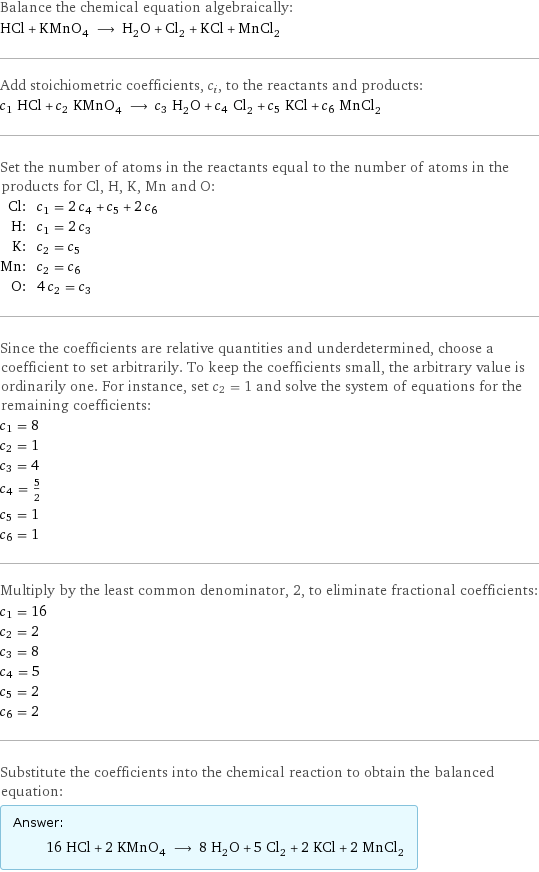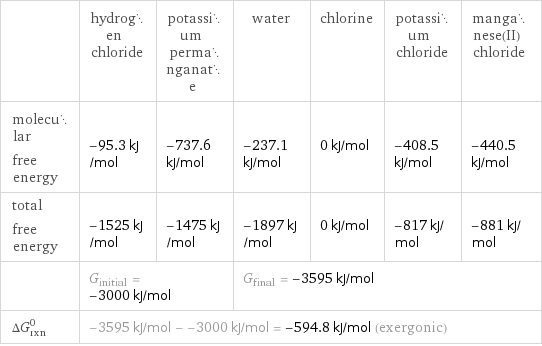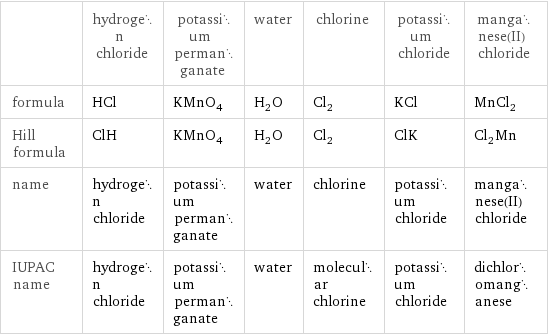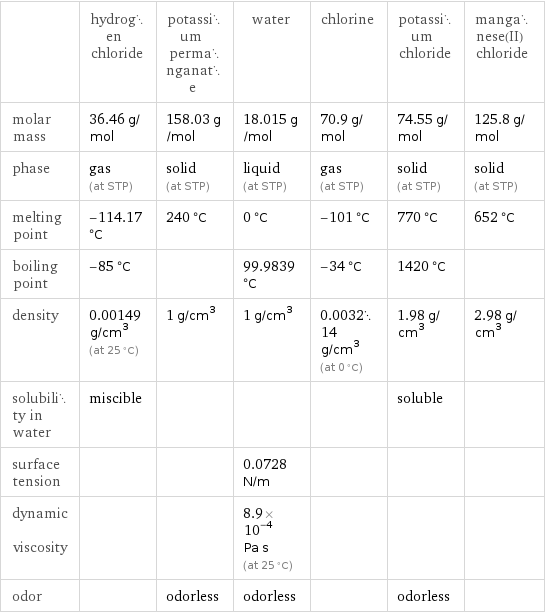Input interpretation

HCl hydrogen chloride + KMnO_4 potassium permanganate ⟶ H_2O water + Cl_2 chlorine + KCl potassium chloride + MnCl_2 manganese(II) chloride
Balanced equation

Balance the chemical equation algebraically: HCl + KMnO_4 ⟶ H_2O + Cl_2 + KCl + MnCl_2 Add stoichiometric coefficients, c_i, to the reactants and products: c_1 HCl + c_2 KMnO_4 ⟶ c_3 H_2O + c_4 Cl_2 + c_5 KCl + c_6 MnCl_2 Set the number of atoms in the reactants equal to the number of atoms in the products for Cl, H, K, Mn and O: Cl: | c_1 = 2 c_4 + c_5 + 2 c_6 H: | c_1 = 2 c_3 K: | c_2 = c_5 Mn: | c_2 = c_6 O: | 4 c_2 = c_3 Since the coefficients are relative quantities and underdetermined, choose a coefficient to set arbitrarily. To keep the coefficients small, the arbitrary value is ordinarily one. For instance, set c_2 = 1 and solve the system of equations for the remaining coefficients: c_1 = 8 c_2 = 1 c_3 = 4 c_4 = 5/2 c_5 = 1 c_6 = 1 Multiply by the least common denominator, 2, to eliminate fractional coefficients: c_1 = 16 c_2 = 2 c_3 = 8 c_4 = 5 c_5 = 2 c_6 = 2 Substitute the coefficients into the chemical reaction to obtain the balanced equation: Answer: | | 16 HCl + 2 KMnO_4 ⟶ 8 H_2O + 5 Cl_2 + 2 KCl + 2 MnCl_2
Structures

+ ⟶ + + +
Names

hydrogen chloride + potassium permanganate ⟶ water + chlorine + potassium chloride + manganese(II) chloride
Reaction thermodynamics
Gibbs free energy

| hydrogen chloride | potassium permanganate | water | chlorine | potassium chloride | manganese(II) chloride molecular free energy | -95.3 kJ/mol | -737.6 kJ/mol | -237.1 kJ/mol | 0 kJ/mol | -408.5 kJ/mol | -440.5 kJ/mol total free energy | -1525 kJ/mol | -1475 kJ/mol | -1897 kJ/mol | 0 kJ/mol | -817 kJ/mol | -881 kJ/mol | G_initial = -3000 kJ/mol | | G_final = -3595 kJ/mol | | | ΔG_rxn^0 | -3595 kJ/mol - -3000 kJ/mol = -594.8 kJ/mol (exergonic) | | | | |
Equilibrium constant
![Construct the equilibrium constant, K, expression for: HCl + KMnO_4 ⟶ H_2O + Cl_2 + KCl + MnCl_2 Plan: • Balance the chemical equation. • Determine the stoichiometric numbers. • Assemble the activity expression for each chemical species. • Use the activity expressions to build the equilibrium constant expression. Write the balanced chemical equation: 16 HCl + 2 KMnO_4 ⟶ 8 H_2O + 5 Cl_2 + 2 KCl + 2 MnCl_2 Assign stoichiometric numbers, ν_i, using the stoichiometric coefficients, c_i, from the balanced chemical equation in the following manner: ν_i = -c_i for reactants and ν_i = c_i for products: chemical species | c_i | ν_i HCl | 16 | -16 KMnO_4 | 2 | -2 H_2O | 8 | 8 Cl_2 | 5 | 5 KCl | 2 | 2 MnCl_2 | 2 | 2 Assemble the activity expressions accounting for the state of matter and ν_i: chemical species | c_i | ν_i | activity expression HCl | 16 | -16 | ([HCl])^(-16) KMnO_4 | 2 | -2 | ([KMnO4])^(-2) H_2O | 8 | 8 | ([H2O])^8 Cl_2 | 5 | 5 | ([Cl2])^5 KCl | 2 | 2 | ([KCl])^2 MnCl_2 | 2 | 2 | ([MnCl2])^2 The equilibrium constant symbol in the concentration basis is: K_c Mulitply the activity expressions to arrive at the K_c expression: Answer: | | K_c = ([HCl])^(-16) ([KMnO4])^(-2) ([H2O])^8 ([Cl2])^5 ([KCl])^2 ([MnCl2])^2 = (([H2O])^8 ([Cl2])^5 ([KCl])^2 ([MnCl2])^2)/(([HCl])^16 ([KMnO4])^2)](../image_source/0fdfdf5627999894c864aedd0987d973.png)
Construct the equilibrium constant, K, expression for: HCl + KMnO_4 ⟶ H_2O + Cl_2 + KCl + MnCl_2 Plan: • Balance the chemical equation. • Determine the stoichiometric numbers. • Assemble the activity expression for each chemical species. • Use the activity expressions to build the equilibrium constant expression. Write the balanced chemical equation: 16 HCl + 2 KMnO_4 ⟶ 8 H_2O + 5 Cl_2 + 2 KCl + 2 MnCl_2 Assign stoichiometric numbers, ν_i, using the stoichiometric coefficients, c_i, from the balanced chemical equation in the following manner: ν_i = -c_i for reactants and ν_i = c_i for products: chemical species | c_i | ν_i HCl | 16 | -16 KMnO_4 | 2 | -2 H_2O | 8 | 8 Cl_2 | 5 | 5 KCl | 2 | 2 MnCl_2 | 2 | 2 Assemble the activity expressions accounting for the state of matter and ν_i: chemical species | c_i | ν_i | activity expression HCl | 16 | -16 | ([HCl])^(-16) KMnO_4 | 2 | -2 | ([KMnO4])^(-2) H_2O | 8 | 8 | ([H2O])^8 Cl_2 | 5 | 5 | ([Cl2])^5 KCl | 2 | 2 | ([KCl])^2 MnCl_2 | 2 | 2 | ([MnCl2])^2 The equilibrium constant symbol in the concentration basis is: K_c Mulitply the activity expressions to arrive at the K_c expression: Answer: | | K_c = ([HCl])^(-16) ([KMnO4])^(-2) ([H2O])^8 ([Cl2])^5 ([KCl])^2 ([MnCl2])^2 = (([H2O])^8 ([Cl2])^5 ([KCl])^2 ([MnCl2])^2)/(([HCl])^16 ([KMnO4])^2)
Rate of reaction
![Construct the rate of reaction expression for: HCl + KMnO_4 ⟶ H_2O + Cl_2 + KCl + MnCl_2 Plan: • Balance the chemical equation. • Determine the stoichiometric numbers. • Assemble the rate term for each chemical species. • Write the rate of reaction expression. Write the balanced chemical equation: 16 HCl + 2 KMnO_4 ⟶ 8 H_2O + 5 Cl_2 + 2 KCl + 2 MnCl_2 Assign stoichiometric numbers, ν_i, using the stoichiometric coefficients, c_i, from the balanced chemical equation in the following manner: ν_i = -c_i for reactants and ν_i = c_i for products: chemical species | c_i | ν_i HCl | 16 | -16 KMnO_4 | 2 | -2 H_2O | 8 | 8 Cl_2 | 5 | 5 KCl | 2 | 2 MnCl_2 | 2 | 2 The rate term for each chemical species, B_i, is 1/ν_i(Δ[B_i])/(Δt) where [B_i] is the amount concentration and t is time: chemical species | c_i | ν_i | rate term HCl | 16 | -16 | -1/16 (Δ[HCl])/(Δt) KMnO_4 | 2 | -2 | -1/2 (Δ[KMnO4])/(Δt) H_2O | 8 | 8 | 1/8 (Δ[H2O])/(Δt) Cl_2 | 5 | 5 | 1/5 (Δ[Cl2])/(Δt) KCl | 2 | 2 | 1/2 (Δ[KCl])/(Δt) MnCl_2 | 2 | 2 | 1/2 (Δ[MnCl2])/(Δt) (for infinitesimal rate of change, replace Δ with d) Set the rate terms equal to each other to arrive at the rate expression: Answer: | | rate = -1/16 (Δ[HCl])/(Δt) = -1/2 (Δ[KMnO4])/(Δt) = 1/8 (Δ[H2O])/(Δt) = 1/5 (Δ[Cl2])/(Δt) = 1/2 (Δ[KCl])/(Δt) = 1/2 (Δ[MnCl2])/(Δt) (assuming constant volume and no accumulation of intermediates or side products)](../image_source/125efe0052a91695dddd1d897632a4ce.png)
Construct the rate of reaction expression for: HCl + KMnO_4 ⟶ H_2O + Cl_2 + KCl + MnCl_2 Plan: • Balance the chemical equation. • Determine the stoichiometric numbers. • Assemble the rate term for each chemical species. • Write the rate of reaction expression. Write the balanced chemical equation: 16 HCl + 2 KMnO_4 ⟶ 8 H_2O + 5 Cl_2 + 2 KCl + 2 MnCl_2 Assign stoichiometric numbers, ν_i, using the stoichiometric coefficients, c_i, from the balanced chemical equation in the following manner: ν_i = -c_i for reactants and ν_i = c_i for products: chemical species | c_i | ν_i HCl | 16 | -16 KMnO_4 | 2 | -2 H_2O | 8 | 8 Cl_2 | 5 | 5 KCl | 2 | 2 MnCl_2 | 2 | 2 The rate term for each chemical species, B_i, is 1/ν_i(Δ[B_i])/(Δt) where [B_i] is the amount concentration and t is time: chemical species | c_i | ν_i | rate term HCl | 16 | -16 | -1/16 (Δ[HCl])/(Δt) KMnO_4 | 2 | -2 | -1/2 (Δ[KMnO4])/(Δt) H_2O | 8 | 8 | 1/8 (Δ[H2O])/(Δt) Cl_2 | 5 | 5 | 1/5 (Δ[Cl2])/(Δt) KCl | 2 | 2 | 1/2 (Δ[KCl])/(Δt) MnCl_2 | 2 | 2 | 1/2 (Δ[MnCl2])/(Δt) (for infinitesimal rate of change, replace Δ with d) Set the rate terms equal to each other to arrive at the rate expression: Answer: | | rate = -1/16 (Δ[HCl])/(Δt) = -1/2 (Δ[KMnO4])/(Δt) = 1/8 (Δ[H2O])/(Δt) = 1/5 (Δ[Cl2])/(Δt) = 1/2 (Δ[KCl])/(Δt) = 1/2 (Δ[MnCl2])/(Δt) (assuming constant volume and no accumulation of intermediates or side products)
Chemical names and formulas

| hydrogen chloride | potassium permanganate | water | chlorine | potassium chloride | manganese(II) chloride formula | HCl | KMnO_4 | H_2O | Cl_2 | KCl | MnCl_2 Hill formula | ClH | KMnO_4 | H_2O | Cl_2 | ClK | Cl_2Mn name | hydrogen chloride | potassium permanganate | water | chlorine | potassium chloride | manganese(II) chloride IUPAC name | hydrogen chloride | potassium permanganate | water | molecular chlorine | potassium chloride | dichloromanganese
Substance properties

| hydrogen chloride | potassium permanganate | water | chlorine | potassium chloride | manganese(II) chloride molar mass | 36.46 g/mol | 158.03 g/mol | 18.015 g/mol | 70.9 g/mol | 74.55 g/mol | 125.8 g/mol phase | gas (at STP) | solid (at STP) | liquid (at STP) | gas (at STP) | solid (at STP) | solid (at STP) melting point | -114.17 °C | 240 °C | 0 °C | -101 °C | 770 °C | 652 °C boiling point | -85 °C | | 99.9839 °C | -34 °C | 1420 °C | density | 0.00149 g/cm^3 (at 25 °C) | 1 g/cm^3 | 1 g/cm^3 | 0.003214 g/cm^3 (at 0 °C) | 1.98 g/cm^3 | 2.98 g/cm^3 solubility in water | miscible | | | | soluble | surface tension | | | 0.0728 N/m | | | dynamic viscosity | | | 8.9×10^-4 Pa s (at 25 °C) | | | odor | | odorless | odorless | | odorless |
Units
